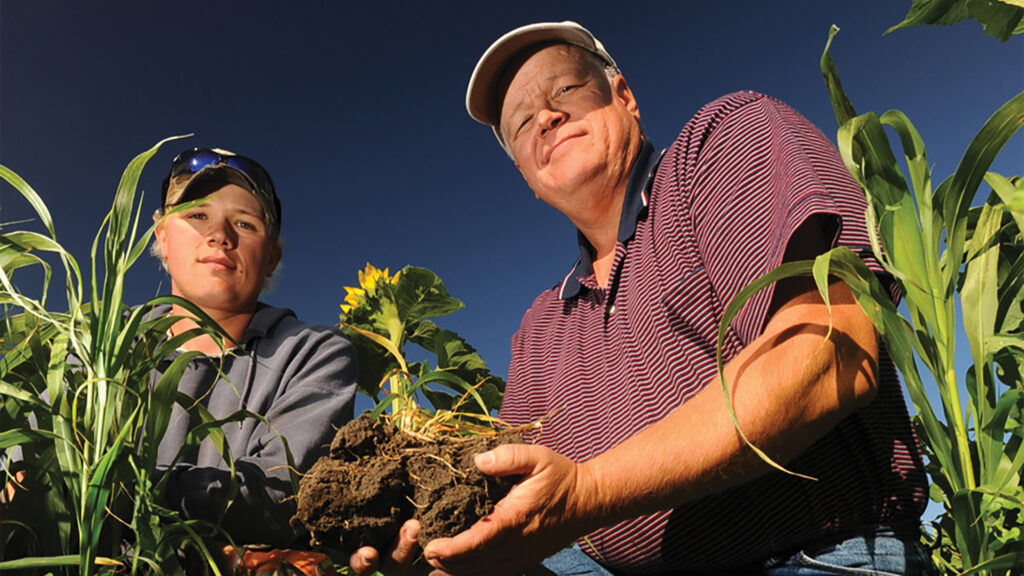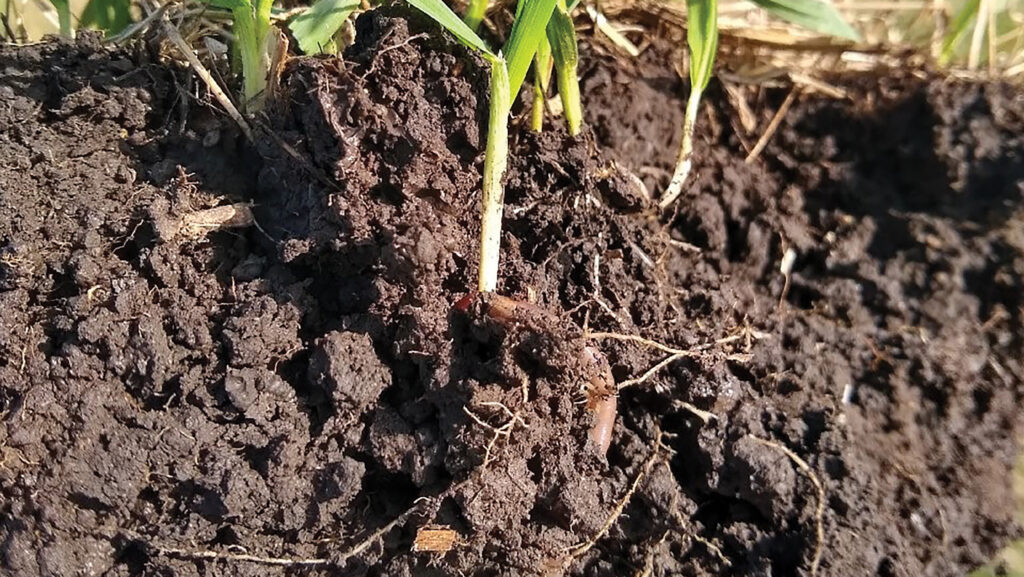Groundswell 2025: Regen farming learnings from Gabe Brown
 Gabe Brown and his son Paul © Gabe Brown
Gabe Brown and his son Paul © Gabe Brown Sunlight is the most powerful resource on farm, but is also underused, suggests world-renowned US regenerative farmer Gabe Brown.
“This is where our income as farmers comes from,” he said during his keynote speech at Groundswell 2025.
“How much sunlight are you capturing on your farm? What percentage is hitting the soil surface? What percent is intercepted by the leaf of a living plant? Because it is only then we can generate true new wealth.”
See also: How Gabe Brown is building regenerative momentum across the world
The goal as farmers is to intercept as much sunlight as possible, he said. “If it is hitting the soil, you’re giving up income.”
But that is typically what farmers growing a monoculture are doing, without employing cover crops, he suggested, as it won’t produce the most biomass or intercept the most sunlight.
“The more functional diversity you have, the more plant biomass. I’d shoot for seven or eight species in a cover crop mix, as you will have more biomass production.”
Root exudates
By capturing sunlight through living plants, carbon compounds are produced, he said.
“A proportion – it varies from 10% to 50% – is translocated to the roots and exuded out into the soil. That feeds the soil biology, which lives in and on thin films of water in the pore spaces between soil aggregates.”
He questioned how many farmers truly understand how soil aggregates are formed.
It is through soil biology, having fed on root exudates – sticky substances which acts as a glue to bind soil particles, he explained.
“A soil aggregate only lasts around four weeks, so you’d better be forming new ones, and as you build aggregation deeper into the soil profile, you access more nutrients.”
Biology is key to making those nutrients available. A test for total nutrients in soil has shown repeatedly that none of the 14.5m hectares of crop and pasture analysed lacked any nutrient available for profitable crop production.
“Most soil tests only tell you the fraction of inorganic nutrients that are available when the sample was taken,” he said.
“But it doesn’t tell you about the pool of organic nutrients that are tied up in biology, dying or decaying plant material and organic matter.
“That pool, if you have the correct biology in your soil, can be made available.
“That’s one of the ways farmers on their regenerative journey can significantly and rapidly increase their profitability, by focusing on life in the soil and increasing biodiversity.”
It was making use of that kind of learning that transformed Gabe’s farm in North Dakota, where he had sunk into a $1.5m (£1.1m) financial hole in the late 1990s following four successive years of arable crop failure.

© Gabe Brown
Regen principles
He turned to six regenerative farming principles – context; minimising disturbance, whether through cultivation or chemical use; covering the soil; enhancing plant diversity; keeping a living root in the soil; and integrating livestock – to drive four ecosystem processes that cycle energy, minerals, water and biodiversity to turn the farm around.
But in a different session at Groundswell he pointed out that the business side was just as important.
“Number one, I had to know my cost of production. We work with several thousand farmers [in the consultancy business Understanding Ag] and it amazes me how few know their true cost of production.”
Knowing costs of production for every enterprise is empowering.
It helped Gabe pinpoint what to continue and what to stop, and to find opportunities, such as growing hairy vetch as a seed crop for which he could obtain a significant premium.
“If I’d stuck to only growing conventional commodities, I wouldn’t have got out of that debt,” he said. “Since we started growing vetch for seed, my average net return is just under $1,000/acre/year [about £1,800/ha/year].”
He also used the screenings from cleaning the vetch and other crops to feed to livestock. “You generate real profit by taking the waste stream from one enterprise to fuel the profit in another.
“That was how I got out of debt by 2012. Find out your cost of production, and then be willing to do something on the farm better than others at a price point that gives you a consistent profit.”
Northumberland example
Building on the profitability theme, Northumberland farmer Stuart Johnson, who has worked closely with Gabe for several years and is now part of the Understanding Ag consultancy team in the UK, has enhanced his farm’s profitability by following the same principles.
“Context was key – how could we make this fit our farm?” he said. Key questions he needed to answer included what type of life and business he was trying to build; what his land was suited for, and whether it could be regenerated at the same time.
“These set the boundary for what’s manageable and meaningful on the farm.”
But most important was the financial context, including for cashflow, creating a business model, and setting environmental, social and economic goals to build each enterprise and continually repeat and review.
“That’s what is going to drive profitability on farm.”
How ecological succession can drive crop performance
All natural landscapes change over time, which is the underlying principle behind the concept of ecological succession, as Understanding Ag consultant Kyle Richardville explained.
“There are two types – primary and secondary. Primary is when a landscape has no soil, just bare rock, and needs pioneer species to weather away minerals from rock and start these ecosystem processes.”
Secondary succession is more important in an agricultural context – that is when there is a major disturbance, such as a forest fire, deforestation or a major tillage or chemical event that hits the reset the button on the landscape.
“In this situation we have conditions where pioneer species are needed, which set the stage for intermediate species to slowly build diversity and abundance.” Kyle said.
Two concepts
Two concepts were important to understand ecological succession: first, species have strategies that give them a comparative advantage under certain circumstances, and second, altering those conditions can change which species have the advantage. “This our point of agency as farmers.”
In an early succession landscape, the four ecosystem processes are inefficient. “Unfortunately, that’s what we see in many agricultural landscapes,” Kyle said.
It encourages plants that are quick to mature, produce a large number of offspring per individual, but have only one or two breeding events in their lifecycle.
This is typical of agricultural weeds, such as grassweeds, and also pathogenic microbes, as well as nitrogen-fixing microbes.
Later succession landscapes were characterised by the opposite, Kyle explained.
Greater ecosystem process efficiency, well-structured soils with higher fungal to bacteria ratios, and more diversity.
“Species are slower to sexual maturity, smaller numbers of offspring but many breeding events and produce strong individuals.”
These environments typically had more checks and balances because of the extra diversity that kept economically damaging species in check.
“But you don’t want to get rid of them as they provide a food source for the ‘good guys’,” he said.
From a farming perspective, over-relying on chemicals or tillage could reset the farmed environment towards an early succession landscape, and “you’re then on a treadmill”.
Many arable soils were in that place, he suggested. “I think they need a rest.
“Give them 1-3 years of living plants in the soil, ideally with livestock grazing, adding biology, manure, stimulating root growth, breaking compaction, before going back into annual production.”
Wiltshire farmer’s view
Joining the panel session for questions, Wiltshire beef and arable farmer George Hosier said he had employed that kind of strategy on a field overrun with blackgrass.
“We whole-cropped in early June, planted a cover crop which we left until 10 October when we planted winter wheat.
“We didn’t apply a pre-emergence herbicide or follow up with any blackgrass herbicide, and five years later we still don’t have any blackgrass problem in the field.”
By growing the summer cover crop, he believes he changed something in the soil.
“There was a lot of biomass, so we put a lot of sugar into the soil, fed the microbes and changed the soil to later succession.
“It was a cashflow hit for me because we didn’t harvest the wheat, but the savings in herbicide have offset that.
“It’s not something I would want to do every year around the farm, but it’s a tool and something we can do as a mixed farm.”

